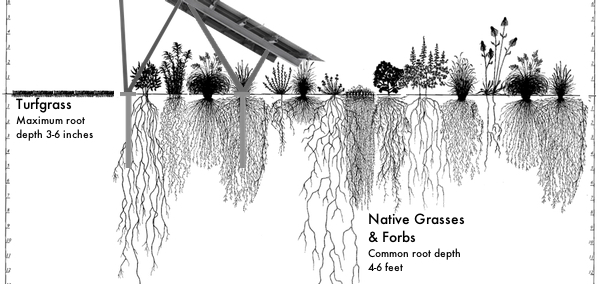
When investing $1-$2 million per acre in solar panels, one tends to focus on the benefits directly generated by the new hardware — 100 percent fuel-free energy with no moving parts. However—simply by using the right seed mix—each of these sites can also provide significant agricultural benefits related to storm water, soil, and crop pollination.
Writing in Cleantechnica, one of the world’s top cleantech-focucused news sites, engineer Jeff Broberg highlights the utility and specific benefits of using native plants on solar sites.
[Compared to row crops,] storm water runoff is reduced 23 percent for the 2-year storm (2.9 inches of rain) and 8 percent for the 100-year storm (7.8 inches of rain). The runoff reduction is dependent on soil types, slopes and existing land cover, but, we find these results are very typical. We believe the actual results will be better than the model suggests…
Further, we expect a mix of prairie plants to provide superior hydrologic performance compared to monocrop turf-grasses that are common on solar sites in some areas of the country. In 2008, the U.S. Geological Survey completed a five-year storm water study in cooperation with a consortium of 19 cities and towns in the area of Madison, Wisconsin that revealed “striking differences between turf and prairie vegetation.” The study found “prairie vegetation had greater median infiltration rates than those with turf grass,” and roots in the prairie vegetation plot were “found to a depth of 4.7 feet compared with 0.46 feet in the turf.”
Broberg went on to highlight how using native grasses and forbs on solar sites can benefit agricultural soils:
In addition to superior storm water management, native plants improve the soil with organic matter over the 20 to 30-year life the project, allowing microorganisms and soil fauna to recover after years of intensive compaction, pesticide and fertilizer application. And, over time, native plants out-compete weeds allowing ground cover to be maintained with just a single annual mow, reducing operating costs.
Published in science journal Ecology and Evolution, Dr. Hannah Feltham writes:
Research has also found that the abundance and diversity of pollinating species visiting crops are positively correlated with the availability of seminatural habitat nearby.
And from the heart of farming country, the Minnesota Department of Agriculture notes in its campaign to promote pollinator habitat on agricultural lands that one-third of our food production requires pollinators, as does livestock forage, and most wild plants that produce seeds.
As farmers and stakeholders throughout the agricultural industry increasingly embrace solar energy to diversify their revenue and reduce their energy costs, look for them to become increasingly savvy to the benefits—pollination, soil quality, and storm water management—that can be generated by what’s under and around the panels.
Read Jeff Broberg’s column in Cleantechnica, Utility and Community Solar Should Use Native Landscaping; Dr. Feltham’s published work in Ecology and Evolution; and Minnesota Dept. of Agriculture’s pro-pollinator education campaign.
Image: Derivative work created with permission from Heidi Natura, Living Habitats. “Root Systems of Prairie Plants” © 1995



